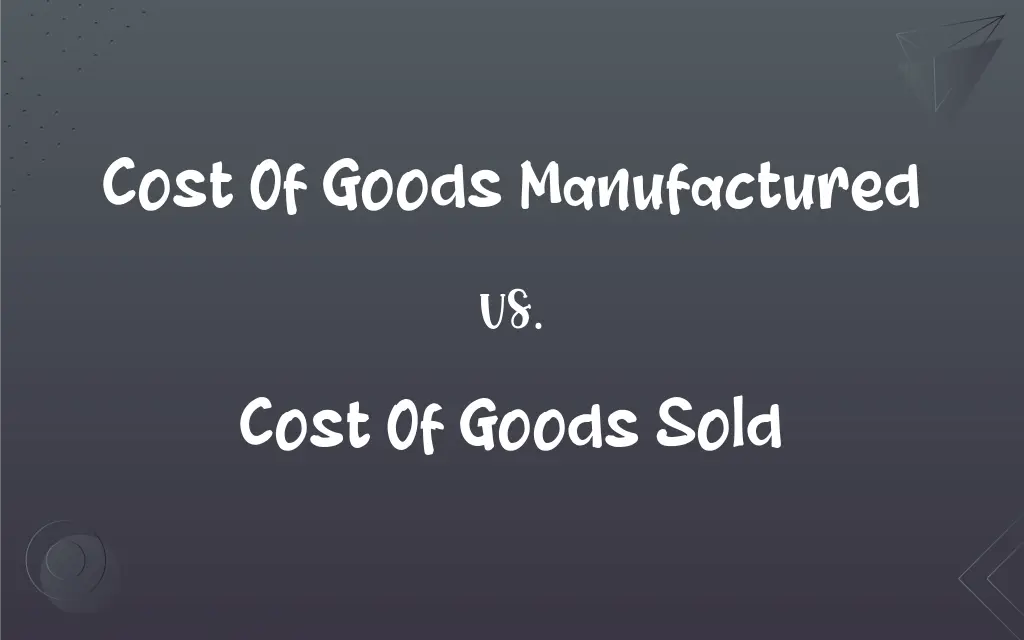Cost Of Goods Manufactured vs. Cost Of Goods Sold: What's the Difference?
Edited by Aimie Carlson || By Janet White || Published on December 6, 2023
Cost of Goods Manufactured (COGM) is the total cost to produce goods, while Cost of Goods Sold (COGS) is the cost of selling those produced goods.

Key Differences
Cost of Goods Manufactured encompasses all costs incurred in producing goods, including materials, labor, and overhead. Cost of Goods Sold refers to the cost of these manufactured goods actually sold to customers, excluding unsold inventory.
COGM is calculated before goods are sold and is a measure of production efficiency and cost control. COGS, however, is recognized in accounting when sales occur, impacting revenue and profit figures.
COGM is vital for inventory valuation in the balance sheet, reflecting the production costs of completed goods. COGS directly affects the gross profit in the income statement, demonstrating the cost efficiency of sales.
COGM helps in determining the optimal pricing strategy by understanding production costs. COGS is crucial for tax purposes, as it is deductible and reduces taxable income based on goods sold.
COGM includes costs up to the completion of goods, whether they are sold or not. COGS accounts only for costs of goods that have been sold, excluding costs related to unsold inventory.
ADVERTISEMENT
Comparison Chart
Definition
Total cost to produce goods.
Cost of selling those produced goods.
Calculation Time
Before goods are sold.
When sales occur.
Financial Impact
Affects inventory valuation.
Affects gross profit and revenue.
Accounting Relevance
Measure of production efficiency.
Reflects cost efficiency of sales.
Costs Included
Materials, labor, overhead for production.
Costs related to goods actually sold.
ADVERTISEMENT
Cost Of Goods Manufactured and Cost Of Goods Sold Definitions
Cost Of Goods Manufactured
COGM is a key figure in determining the cost base of inventory.
The increase in COGM affected the pricing strategy for their products.
Cost Of Goods Sold
COGS is the cost of inventory sold during a particular period.
The company's COGS was key in calculating their gross profit.
Cost Of Goods Manufactured
COGM is the total cost incurred in the production of goods.
The company's COGM increased due to higher raw material costs.
Cost Of Goods Sold
COGS is deducted from revenue to determine gross profit.
Lower COGS contributed to a higher gross margin this quarter.
Cost Of Goods Manufactured
It includes material, labor, and overhead costs in manufacturing.
Their COGM was calculated to evaluate production efficiency.
Cost Of Goods Sold
COGS is essential for tax purposes and financial reporting.
Accurate COGS calculation was crucial for their tax filings.
Cost Of Goods Manufactured
COGM is used to assess the cost control in manufacturing processes.
A reduction in COGM showed improved cost management.
Cost Of Goods Sold
It reflects the cost of goods that have actually been sold.
The store's COGS helped in understanding the profitability of sales.
Cost Of Goods Manufactured
It reflects the total production cost before goods are sold.
The company's COGM was critical for year-end inventory valuation.
Cost Of Goods Sold
It includes direct costs like materials and labor for sold goods.
Their COGS increased in line with higher sales volumes.
FAQs
What is the Cost of Goods Manufactured?
It's the total cost involved in producing goods, including materials, labor, and overhead.
When is COGM calculated?
COGM is calculated before the sale of goods, usually at the end of a production cycle.
What does COGS represent in financial statements?
COGS represents the direct costs associated with goods that have been sold, affecting gross profit.
How is the Cost of Goods Sold defined?
It's the cost of inventory that has been sold, including direct costs like materials and labor.
What impact does COGS have on gross profit?
COGS is deducted from sales revenue to determine gross profit.
Does COGM include labor costs?
Yes, COGM includes direct labor costs involved in manufacturing the goods.
Are overhead costs part of COGM?
Yes, manufacturing overhead costs are included in COGM.
Can COGS affect a company's taxable income?
Yes, COGS is deducted from revenue, thereby affecting taxable income.
How does COGM impact inventory valuation?
COGM affects the value of inventory on the balance sheet, reflecting the cost of completed goods.
Is COGM relevant for all types of businesses?
COGM is mainly relevant for manufacturing and production-based businesses.
Can COGM change with production efficiency?
Yes, improvements in production efficiency can reduce COGM.
Does COGM include indirect costs?
COGM includes indirect manufacturing costs like factory overhead.
How does COGM relate to product pricing?
COGM influences the base cost, which is critical in setting product prices.
Are returns and allowances part of COGS?
No, returns and allowances are treated separately from COGS in accounting.
How is COGS used in pricing strategy?
COGS is used to determine the minimum selling price to ensure profitability.
How do sales volume changes affect COGS?
COGS increases or decreases in line with changes in sales volumes.
Is COGS the same as selling expenses?
No, COGS is related to the cost of goods sold, while selling expenses are costs incurred in selling the product.
Are discounts considered in COGS?
No, discounts are not included in COGS; they are treated separately in financial statements.
Can COGM be used for budgeting?
Yes, COGM is a crucial figure for budgeting in manufacturing processes.
Is depreciation included in COGS?
Depreciation of production equipment is typically included in COGS.
About Author
Written by
Janet WhiteJanet White has been an esteemed writer and blogger for Difference Wiki. Holding a Master's degree in Science and Medical Journalism from the prestigious Boston University, she has consistently demonstrated her expertise and passion for her field. When she's not immersed in her work, Janet relishes her time exercising, delving into a good book, and cherishing moments with friends and family.
Edited by
Aimie CarlsonAimie Carlson, holding a master's degree in English literature, is a fervent English language enthusiast. She lends her writing talents to Difference Wiki, a prominent website that specializes in comparisons, offering readers insightful analyses that both captivate and inform.






































































